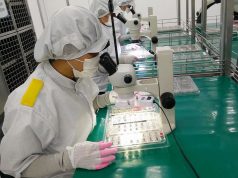Enhanced information campaign
The Department of Health (DoH) data showed a sharp increase in the number of hospital admissions due to coronavirus disease 2019 (COVID-19) in the period Feb. 21 to March 6, after remaining steady throughout the start of the year to about late-February. A recent study by the Octa Research Group indicated that the average number of new cases increased by 130%.
Octa warned that if the increase in new cases is not controlled, the Philippines may see 6,000 new cases daily by March 31. The number of new cases last Saturday, March 13, was already 5,000.
Octa suspects the surge can be traced to the presence in the country of new COVID-19 variants like those from the United Kingdom and South Africa as the original strain does not spread as fast.
But DoH Undersecretary Maria Rosario Vergeire said the rise in COVID-19 cases cannot be attributed solely to the more infectious variants as health guidelines have remained the same.
She believes that non-compliance with minimum health protocols is the main reason for the spike in the number of cases.
Octa believes that measures can still be taken to arrest the rise in cases and possibly reverse the trend by implementing localized lockdowns and stricter border controls to prevent transmission from one area to another. Aside from that, the government should begin the vaccination program this month, with the health workers given priority.
VACCINATION PROGRAM
The nation’s vaccination program is key to the immunization of the population to COVID-19. The government aims to vaccinate 70% of the 100 million population by the end of 2022 to achieve herd immunity. Based on the way Vaccine Czar Carlito Galvez has handled the procurement of the needed amount of vaccine, it is very unlikely that the target of 70 million Filipinos vaccinated by December of 2022 will be achieved.
First, he has signed deals for only about one-third of the doses needed. Second, distributing the vaccines all over the archipelago is a much more herculean task than procuring the vaccines. For instance, the initial order of vaccines arrived on Feb. 28. Health workers are supposed to be first in the line of recipients. Dr. Jose Rene de Grano, president of the Private Hospitals Association of the Philippines, complained on television last Friday that the health workers of his hospital in San Juan, Batangas, have not been vaccinated as no delivery of vaccine has been made to the hospital, which is in the island of Luzon.
To vaccinate 70 million Filipinos, who are distributed over so many islands, some of which do not have the refrigerated storage facilities required by the vaccines, may take well beyond 2022. And by the time the people of Samar, Palawan, Zamboanga, and Sarangani have been vaccinated, the efficacy of the vaccine administered on the residents of the National Capital Region would have expired and rendered the initial recipients susceptible again to COVID-19.
Given our incompetent, indolent, and fraudulent bureaucracy, herd immunity in the Philippines is a pipe dream.
STRINGENT LOCKDOWN
The COVID-19 pandemic required the government to impose stringent lockdown measures exactly a year ago today to help both the public health officials and local government administrators respond effectively to the health crisis. The lockdown shut down 75% of the economy. Metro Manila, which accounts for 37.5% of GDP, came to a standstill.
The main growth drivers of the economy — services, manufacturing, and agriculture — almost ground to a halt. Services, which account for 57% of our economy, became very scarce as those rendering services could not get to their places of work or points of service such as restaurants, hotels, retail outlets, repair shops, resorts, and entertainment houses as travel was restricted.
Manufacturing, which comprises 33% of the economy, tapered considerably as the personnel who operate the machines could not report for work. Only factories of essential goods such as food, medicines, and personal care products were allowed to run.
Agriculture, which constitutes 10% of the economy, suffered major setbacks. While it continued to be productive, its produce could not be transported from farm to market, bagsakan (depots), or transport stations for shipment to the grand central markets of large cities. The GDP plunged by 9.5%, the largest drop since 1946.
Imposing again enhanced general quarantine would place the economy on the verge of collapse. Placing a community under enhanced quarantine at this point might bring about its demise as a unit.
ENHANCED INFORMATION CAMPAIGN
If non-compliance with basic health protocols — proper wearing of mask and face shield, physical distancing, hand-washing, and avoidance of large gathering — is the reason for the increasing number of COVID-19 infections, as DoH’s Dr. Vergeire opines, then the DoH should launch a new information campaign, this time focused on the importance of the proper wearing of masks and face shields owing to the gravity of COVID-19 infection.
Many believe that COVID-19 is not as deadly as it is presented to be. The DoH daily reports give the impression that less than 1% of the 100 million Filipinos have been infected and of those infected, 89% recovered. Prominent personalities like Senators Mig Zubiri, Koko Pimentel, and Sonny Angara, Cabinet members Francisco Duque and Eduardo Año, Cardinal Luis Antonio Tagle and Bishop Broderick Pabillo have recovered, and except for Secretary Año, are back on their feet and performing their duties.
Public Attorney Persida Acosta instilled in the minds of millions of Filipinos a fear of vaccines when she filed criminal charges on the basis of the death of four children supposedly due to Dengvaxia. Her charges were sensationalized by ABS-CBN broadcasters Noli de Castro, Ted Failon, Anthony Taberna, and Gerry Baja. That fear of vaccines can be said to be the main cause of many Filipinos’ resistance to COVID-19 vaccines.
Maybe the DoH’s new information campaign should be the deadliness of COVID-19 and its variants. If the death of four schoolchildren allegedly due to their inoculation with Dengvaxia could cause a nationwide fear of vaccines, the deaths of 12,766 Filipinos due to COVID-19 should infuse intense fear of the coronavirus among Filipinos.
The new information campaign can adopt the message strategy (called copy strategy in advertising) used in the advertisements for consumer products like laundry detergents. Describe the problematic situation, then present the solution. The DoH can highlight the average daily death toll of 35 due to COVID-19, then present the proper wearing of mask and face shield as the best defense next to vaccination against the coronavirus.
In order to draw sustained attention, showbiz celebrities should be used to demonstrate the proper use of the face guards.
Oscar P. Lagman, Jr. is a retired corporate executive, business consultant, and management professor. He has been a politicized citizen since his college days in the late 1950s.



